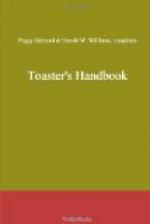“To explain the nature of laughter and tears is to account for the condition of human life,” says Hazlitt, and no philosophy has as yet succeeded in accounting for the condition of human life. “Man is a laughing animal,” wrote Meredith, “and at the end of infinite search the philosopher finds himself clinging to laughter as the best of human fruit, purely human, and sane, and comforting.” So whether it be the corrective laughter of Bergson, Jove laughing at lovers’ vows, Love laughing at locksmiths, or the cheerful laughter of the fool that was like the crackling of thorns to Koheleth, the preacher, we recognize that it is good; that without this saving grace of humor life would be an empty vaunt. I like to recall that ancient usage: “The skie hangs full of humour, and I think we shall haue raine.” Blessed humor, no less refreshing today than was the humour of old to a parched and thirsty earth.
TOASTERS, TOASTMASTERS AND TOASTS
Before making any specific suggestions to the prospective toaster or toastmaster, let us advise that he consider well the nature and spirit of the occasion which calls for speeches. The toast, after-dinner talk, or address is always given under conditions that require abounding good humor, and the desire to make everybody pleased and comfortable as well as to furnish entertainment should be uppermost.
Perhaps a consideration of the ancient custom that gave rise to the modern toast will help us to understand the spirit in which a toast should be given. It originated with the pagan custom of drinking to gods and the dead, which in Christian nations was modified, with the accompanying idea of a wish for health and happiness added. In England during the sixteenth century it was customary to put a “toast” in the drink, which was usually served hot. This toast was the ordinary piece of bread scorched on both sides. Shakespeare in “The Merry Wives of Windsor” has Falstaff say, “Fetch me a quart of sack and put a toast in’t.” Later the term came to be applied to the lady in whose honor the company drank, her name serving to flavor the bumper as the toast flavored the drink. It was in this way that the act of drinking or of proposing a health, or the mere act of expressing good wishes or fellowship at table came to be known as toasting.
Since an occasion, then, at which toasts are in order is one intended to promote good feeling, it should afford no opportunity for the exploitation of any personal or selfish interest or for anything controversial, or antagonistic to any of the company present. The effort of the toastmaster should be to promote the best of feeling among all and especially between speakers. And speakers should cooperate with the toastmaster and with each other to that end. The introductions of the toastmaster may, of course, contain some good-natured bantering, together with compliment, but always without sting. Those taking part may “get back” at the toastmaster, but always in a manner to leave no hard feeling anywhere. The toastmaster should strive to make his speakers feel at ease, to give them good standing with their hearers without overpraising them and making it hard to live up to what is expected of them. In short, let everybody boost good naturedly for everybody else.




